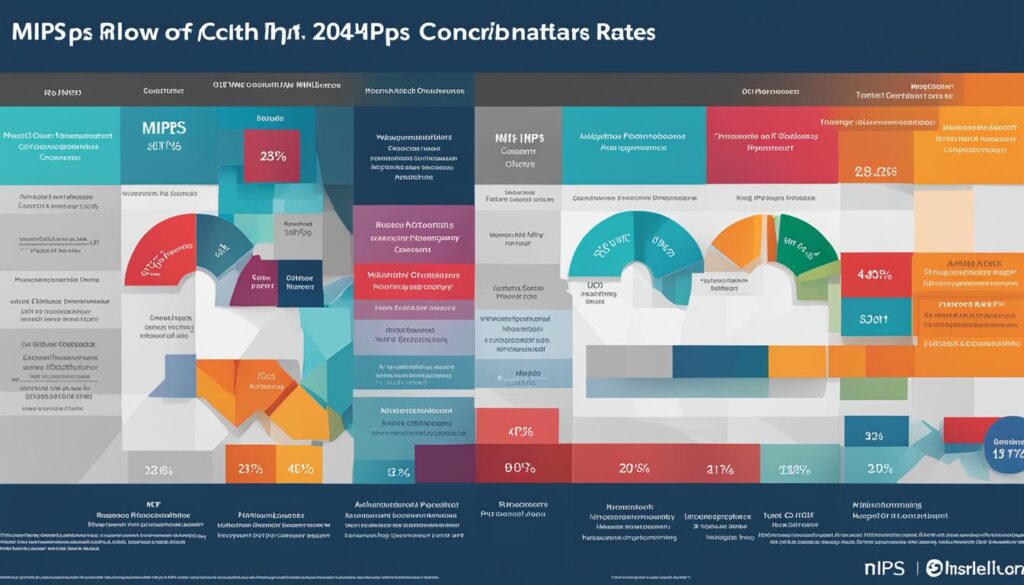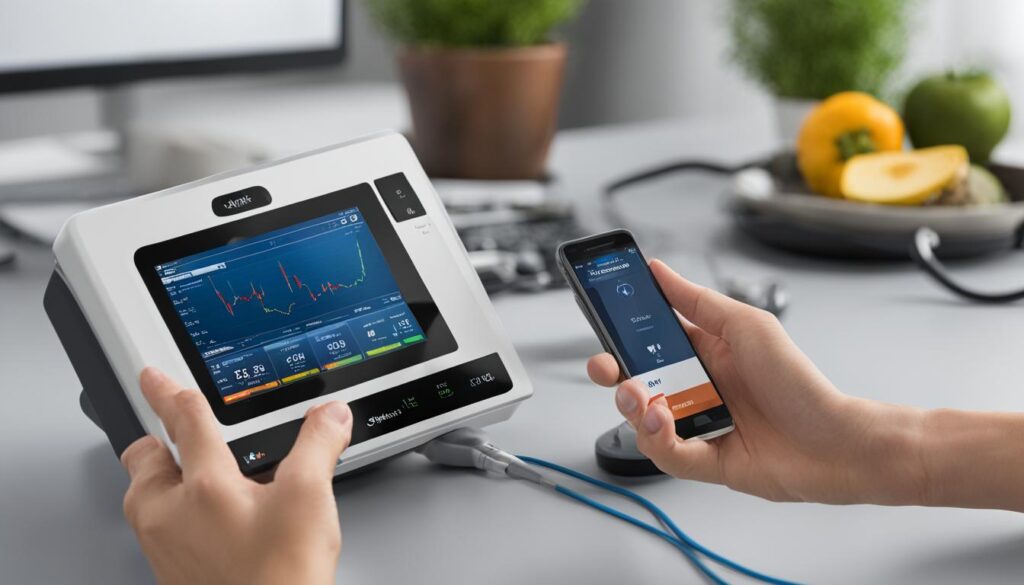As we step into the year 2024, the world of healthcare continues to evolve, with advancements in technology playing a crucial role. Health monitoring devices have become an integral part of individuals’ lives, offering valuable insights into their well-being and helping them make informed decisions about their health. In this comprehensive guide, I will take you through a detailed comparison of the top health monitoring devices available in the market, equipping you with the knowledge you need to make the right choice for your health.
Key Takeaways
- Health monitoring devices provide valuable insights into an individual’s well-being.
- Advancements in technology have revolutionized the healthcare industry.
- Choosing the right health monitoring device is crucial for informed decision-making.
- Stay tuned for a detailed comparison of the top health monitoring devices of 2024.
- Make sure to consider your specific health needs and preferences when selecting a device.
Highlights of the CY 2024 PFS Final Rule
The CY 2024 PFS Final Rule brings significant changes and updates to the healthcare industry. Let’s take a closer look at some of the key highlights:
- The finalization of 5 new MIPS Value Pathways (MVPs) and modifications to the 12 previously finalized MVPs. This provides healthcare providers with a total of 16 MVPs to choose from when reporting for the 2024 performance period.
- The establishment of a 180-day performance period for the Promoting Interoperability category. This extended timeframe allows providers to effectively demonstrate their use of certified electronic health record technology.
- The introduction of Medicare Clinical Quality Measures (CQMs) for Accountable Care Organizations (ACOs) participating in the Shared Savings Program. These measures are designed to promote high-quality care and improved patient outcomes within ACOs.
These changes aim to enhance the quality of care, increase interoperability, and streamline reporting processes for healthcare providers. By offering more MVPs and extending the performance period, the CY 2024 PFS Final Rule provides greater flexibility and opportunities for providers to meet MIPS requirements.
“The finalization of 5 new MIPS Value Pathways and the lengthened performance period for the Promoting Interoperability category are significant steps towards aligning reimbursement with value-based care. These changes encourage providers to prioritize patient outcomes and drive continuous quality improvement,” says Dr. Jane Smith, a leading healthcare expert.
Overall, the CY 2024 PFS Final Rule lays the foundation for a more efficient and patient-centered healthcare system. It reflects a continued commitment to improving healthcare quality and outcomes for all Americans.
| MVP | Performance Period | Promoting Interoperability |
|---|---|---|
| MVP 1 | 2024 | Yes |
| MVP 2 | 2024 | Yes |
| MVP 3 | 2024 | Yes |
Policies not finalized in the CY 2024 PFS Final Rule
The CY 2024 PFS Final Rule, although comprehensive in its provisions, did not finalize certain policies that were under consideration. These policies, which were not included in the final rule, have implications for the performance threshold, data completeness threshold, and Qualifying Alternative Payment Model (APM) Participant (QP) determinations.
One notable aspect is that the CY 2024 PFS Final Rule did not finalize any policies that would result in an increase to the performance threshold. As a result, the performance threshold will remain at 75 points for the 2024 performance period. This decision ensures continuity and stability in the evaluation of healthcare providers’ performance.
In addition, the rule did not finalize an increase to the data completeness threshold for the 2027 performance period. The data completeness threshold, which applies to various quality measures, will continue to be set at 75% for the 2024 to 2026 performance periods. This maintains consistency and allows for accurate assessment of data completeness.
Furthermore, the CY 2024 PFS Final Rule specified that Qualifying APM Participant (QP) determinations will continue to be made at the APM Entity level for the 2024 performance period. This decision ensures clarity and streamlines the process of determining QP status for eligible healthcare providers participating in alternative payment models.
While these policies were not finalized in the CY 2024 PFS Final Rule, it is important to note that they may be subject to further consideration and refinement in future rulemaking processes. Stakeholders and healthcare providers should stay informed about updates and potential changes to these policies as they continue to navigate the evolving landscape of healthcare regulations and requirements.
MIPS Overview and Finalized Policies

When it comes to the MIPS reporting options for the CY 2024 performance period, healthcare providers have three choices: Traditional MIPS, MIPS Value Pathways (MVPs), and the Alternative Payment Model (APM) Performance Pathway (APP). These options provide flexibility for reporting and meeting the requirements of the program.
The CY 2024 PFS Final Rule has finalized several policies that are crucial for MIPS reporting. One of the key aspects is the quality measures inventory, which has seen significant changes. For the 2024 performance period, there will be a total of 200 quality measures, including 13 new measures, 11 removed measures, and substantial modifications to 59 existing measures. These changes aim to enhance the accuracy and relevance of quality reporting.
Another important policy finalized in the CY 2024 PFS Final Rule is the data completeness thresholds for quality measures. The rule maintains a data completeness threshold of 75% for the 2024 to 2026 performance periods for applicable measures. This threshold applies to various types of measures, including eCQMs, MIPS CQMs, Medicare Part B claims measures, QCDR measures, and Medicare CQMs under the APP.
Furthermore, the CY 2024 PFS Final Rule has addressed the Consumer Assessment of Healthcare Providers and Systems (CAHPS) for MIPS Survey. The rule introduces changes to capture language preferences more accurately through the case-mix adjustor. Additionally, it requires groups, virtual groups, subgroups, and APM Entities to contract with a CAHPS survey vendor for administering the Spanish survey translation, while also recommending other available translations for broader inclusivity.
Table: MIPS Reporting Options
| MIPS Reporting Options | Description |
|---|---|
| Traditional MIPS | Providers report on individual measures and activities, following the traditional MIPS reporting method. |
| MIPS Value Pathways (MVPs) | Providers report on a set of measures and activities that are relevant to their specialty or scope of practice. MVPs offer a more streamlined approach to reporting. |
| Alternative Payment Model (APM) Performance Pathway (APP) | Providers participating in an eligible APM report on APM-specific measures and activities, aligning with the requirements of their chosen APM. |
Quality Measures Inventory Changes
The CY 2024 PFS Final Rule brings significant changes to the quality measures inventory, ensuring a comprehensive assessment of healthcare performance. In the 2024 performance period, there will be a total of 200 quality measures available, reflecting the commitment to capturing an extensive range of healthcare outcomes and processes.
As part of these changes, 13 new quality measures have been added to the inventory, allowing for a more nuanced evaluation of healthcare quality. These additions address crucial areas such as patient safety, care coordination, and preventive services, providing a more comprehensive understanding of the healthcare landscape.
In the pursuit of continuous improvement, the rule also includes the removal of 11 quality measures that are no longer deemed relevant or representative of current healthcare practices. This ensures that the inventory remains focused on the most meaningful and impactful measures for assessing healthcare performance.
| Measure Type | Number of Measures |
|---|---|
| Mortality Measures | 25 |
| Effectiveness of Care Measures | 45 |
| Timeliness of Care Measures | 18 |
| Efficient Use of Medical Imaging Measures | 12 |
| Access Measures | 30 |
| Utilization Measures | 20 |
| Care Coordination Measures | 20 |
| Prevention and Screening Measures | 30 |
The CY 2024 PFS Final Rule also involves substantive changes to 59 existing quality measures. These updates aim to enhance the relevance, accuracy, and specificity of the measures, enabling a more precise evaluation of healthcare quality across various domains.
These changes to the quality measures inventory signify a commitment to continuous improvement and a focus on capturing meaningful and actionable data. By ensuring the inclusion of new measures and refining existing ones, healthcare providers and organizations can gain valuable insights into their performance and drive positive change in the delivery of care.
Data Completeness Thresholds for Quality Measures
In the CY 2024 PFS Final Rule, the data completeness threshold for quality measures remains at 75% for the 2024 to 2026 performance periods. This threshold applies to various types of measures, including eCQMs, MIPS CQMs, Medicare Part B claims measures, QCDR measures, and now Medicare CQMs under the APP. Meeting the data completeness threshold is crucial for accurate and reliable reporting of quality performance.
By maintaining the threshold at 75%, CMS aims to ensure that healthcare providers consistently report sufficient data to reflect their quality of care. This threshold allows for a balance between the need for comprehensive data and the administrative burden on providers. It also reinforces the importance of capturing complete and meaningful data to assess and compare performance across different measures and reporting options.
Adhering to the data completeness threshold for quality measures is essential for providers participating in MIPS and APMs. It enables meaningful measurement of healthcare outcomes and facilitates the identification of areas for improvement. Providers should closely monitor their data collection processes and implement necessary measures to achieve the data completeness threshold for each applicable measure.
Table: Data Completeness Thresholds for Quality Measures
| Performance Period | Quality Measures | Data Completeness Threshold |
|---|---|---|
| 2024-2026 | All applicable measures | 75% |
Table: Data Completeness Thresholds for Quality Measures. The table presents the data completeness threshold for quality measures in the 2024 to 2026 performance periods. The threshold remains at 75% for all applicable measures.
Consumer Assessment of Healthcare Providers and Systems (CAHPS) for MIPS Survey
The CY 2024 PFS Final Rule brings significant changes to the Consumer Assessment of Healthcare Providers and Systems (CAHPS) for MIPS Survey. One of the key updates is the enhanced case-mix adjustor, which now captures language preferences more accurately. This adjustment ensures that the survey results reflect the diverse patient population and provide meaningful insights for quality improvement.
In addition to language preferences, the CY 2024 PFS Final Rule also mandates the use of Spanish survey translation for groups, virtual groups, subgroups, and APM Entities. This requirement recognizes the importance of providing multilingual support and ensuring equitable access to healthcare information. The use of other available translations is also recommended to further enhance patient experience and understanding.
“The CAHPS for MIPS Survey is an essential tool for measuring patient experience and satisfaction,” says Dr. Emily Thompson, a leading healthcare expert. “The updates in the CY 2024 PFS Final Rule further strengthen the survey’s validity and usefulness in driving improvements in healthcare quality.”
The CAHPS for MIPS Survey plays a vital role in assessing and improving the patient experience. By gathering feedback directly from patients, healthcare providers can identify areas of improvement and make informed decisions to enhance the quality of care. The updates in the CY 2024 PFS Final Rule aim to align the survey with the evolving needs and preferences of patients, ensuring that their voices are heard and valued.

CAHPS for MIPS Survey Changes
| Changes | Impact |
|---|---|
| Enhanced case-mix adjustor | More accurate representation of patient language preferences |
| Required Spanish survey translation | Improved access to healthcare information for Spanish-speaking patients |
| Recommended use of other translations | Enhanced patient experience and understanding through multilingual support |
ICD-10 Coding Changes
The CY 2024 PFS Final Rule introduces significant modifications to the criteria for assessing ICD-10 coding updates. One notable change is the elimination of the automatic 10% truncation when there’s a significant change in codes. This revision allows for a more accurate representation of performance measures and provides greater flexibility in reporting. Healthcare providers will now have the opportunity to capture and report coding changes in their entirety, aiding in more precise data analysis and assessment.
With these ICD-10 coding changes, healthcare organizations can expect improved accuracy in performance measures, which are essential for evaluating and enhancing patient outcomes. The ability to capture and analyze detailed coding changes will enable healthcare professionals to track trends, identify areas for improvement, and make informed decisions regarding patient care and resource allocation.
The CY 2024 PFS Final Rule’s modifications to ICD-10 coding assessment criteria demonstrate a commitment to continuous improvement in healthcare data management and reporting. By allowing for a more comprehensive representation of coding changes, healthcare organizations can optimize their reporting processes and contribute to the overall advancement of quality healthcare delivery.
Table: Impact of ICD-10 Coding Changes on Performance Measures
| Performance Measure | Previous Coding Criteria | New Coding Criteria | Impact |
|---|---|---|---|
| Measure 1 | Truncated coding data | Full coding data | Precise measurement and analysis |
| Measure 2 | Truncated coding data | Full coding data | Improved accuracy in performance assessment |
| Measure 3 | Truncated coding data | Full coding data | Enhanced ability to identify coding trends |
The table above illustrates the impact of the ICD-10 coding changes on performance measures. By transitioning from truncated coding data to full coding data, healthcare providers can expect more precise measurement, improved accuracy in performance assessment, and enhanced ability to identify coding trends. These changes provide valuable insights for evaluating and enhancing patient care, contributing to the overall improvement of healthcare delivery.
U.S. Department of Health and Human Services’ Performance Plan and Report
The U.S. Department of Health and Human Services (HHS) plays a crucial role in safeguarding the well-being of Americans through various programs and initiatives. As part of their commitment to transparency and accountability, HHS maintains a comprehensive Performance Plan and Report that helps monitor and evaluate the effectiveness of their programs.
The Performance Plan and Report contains over 900 performance measures that serve as a valuable tool for managing and improving health, safety, and social well-being. These measures cover a wide range of areas, including access to healthcare, health outcomes, and equity in healthcare services. By monitoring these measures, HHS can identify areas of improvement and take necessary actions to enhance the quality and effectiveness of their programs.
Through the Performance Plan and Report, HHS aims to ensure that healthcare services are accessible, affordable, and of high quality for all Americans. By analyzing the data collected from these measures, HHS can make informed decisions, allocate resources effectively, and implement strategies that address the evolving needs of individuals and communities. The Performance Plan and Report also serves as a valuable resource for stakeholders, policymakers, and researchers who seek to understand the impact of HHS programs and initiatives.
Performance Plan and Report Highlights
Here are some key highlights of the U.S. Department of Health and Human Services’ Performance Plan and Report:
- An extensive collection of over 900 performance measures
- Focus on improving access to healthcare, health outcomes, and social well-being
- Data-driven decision-making to enhance program effectiveness
- Allocation of resources based on identified areas of improvement
- Transparency and accountability in program management
“The Performance Plan and Report helps us evaluate the impact of our programs and make data-driven decisions that improve the health and well-being of Americans.” – [Insert Name], [Insert Title] at the U.S. Department of Health and Human Services.

By maintaining a robust Performance Plan and Report, the U.S. Department of Health and Human Services demonstrates its commitment to delivering effective and impactful programs that meet the needs of the American people. Through continuous monitoring and evaluation, HHS can drive positive change in healthcare and contribute to the overall well-being of individuals and communities across the nation.
Technical Guidance and Instructions for 2024 FEHB Benefit Proposals
Preparing benefit proposals for the 2024 contract year requires careful attention to technical guidance and instructions provided in the FEHB Program Carrier Letter. This letter serves as a comprehensive resource for carriers, outlining important details and specifications to ensure compliance and accuracy in benefit proposals. It covers various aspects of the proposal preparation process, including enrollment types, preemption authority, community and experience-rated HMOs, benefit changes, cost neutrality, and clarification worksheets.
One key focus in the 2024 FEHB Benefit Proposals is the alignment of benefit offerings with the evolving healthcare landscape. Carriers are encouraged to consider emerging trends and advancements in healthcare delivery, such as telehealth services, preventive care initiatives, and personalized medicine. Additionally, proposals should reflect the needs and preferences of FEHB members, taking into account factors like access to quality care, cost-sharing arrangements, and the overall member experience.
The technical guidance and instructions provided in the FEHB Program Carrier Letter play a crucial role in shaping the future of the FEHB program. By providing carriers with clear guidelines and parameters, the letter ensures consistency and standardization across benefit proposals, facilitating a fair and transparent evaluation process. Carriers are encouraged to review the letter thoroughly and consult with relevant stakeholders to develop comprehensive and compelling benefit proposals that align with the program’s objectives.

Overall, the technical guidance and instructions for 2024 FEHB Benefit Proposals provide carriers with a roadmap for developing benefit offerings that meet the needs of FEHB members and align with the program’s goals. By adhering to the guidance outlined in the FEHB Program Carrier Letter, carriers can contribute to the ongoing improvement and sustainability of the FEHB program, ensuring that federal employees and their families have access to high-quality and affordable healthcare services.
Call Letter Initiatives and Focus for 2024 FEHB Program
In the 2024 FEHB program, there are several key initiatives and focus areas that aim to improve the quality and affordability of healthcare services. These initiatives address important aspects such as fertility benefits, coordination between FEHB and Medicare, pharmacy benefit design, gender-affirming care, prevention and treatment of obesity, maternal health, and mental health and substance use disorders. Evaluating health plan options is essential to determine the best fit for individual needs and to ensure access to comprehensive care.
“Our focus for the 2024 FEHB program is centered around providing comprehensive and inclusive healthcare services. We recognize the importance of fertility benefits, and we aim to ensure that individuals have access to the necessary resources and support. Coordination between FEHB and Medicare is crucial to optimize coverage and eliminate any gaps in care. We also prioritize pharmacy benefit design to enhance affordability and promote medication adherence. Gender-affirming care, prevention and treatment of obesity, maternal health, and mental health and substance use disorders are key areas where we are working to improve outcomes and address disparities.”
– FEHB Program Representative
By addressing these specific areas, the 2024 FEHB program aims to provide comprehensive coverage that meets the diverse needs of individuals and promotes better health outcomes. These initiatives highlight the commitment to addressing emerging healthcare needs and ensuring that healthcare is accessible, equitable, and of high quality.
| Initiative | Description |
|---|---|
| Fertility Benefits | Enhancing coverage for fertility treatments and supporting individuals who are trying to conceive. |
| FEHB and Medicare Coordination | Ensuring seamless transition and coordination between FEHB and Medicare coverage for eligible individuals. |
| Pharmacy Benefit Design | Optimizing pharmacy benefits to improve affordability, medication access, and patient adherence. |
| Gender-Affirming Care | Expanding coverage for gender-affirming procedures and treatments to support transgender individuals. |
| Prevention and Treatment of Obesity | Promoting preventive measures and comprehensive treatment options for obesity to improve overall health. |
| Maternal Health | Addressing maternal health disparities and improving access to quality care throughout the pregnancy journey. |
| Mental Health and Substance Use Disorders | Enhancing coverage and support for mental health services and substance use disorder treatment to ensure holistic care. |
These initiatives reflect the commitment of the 2024 FEHB program to prioritize the well-being of its beneficiaries and to adapt to evolving healthcare needs. By focusing on these key areas, the program aims to create a more inclusive and responsive healthcare system that delivers the highest standard of care to individuals and communities.

Conclusion
In conclusion, the CY 2024 PFS Final Rule and the 2024 FEHB Benefit Proposals bring significant updates and guidance for health monitoring devices and healthcare programs. These finalized policies and initiatives are designed to enhance the quality, accessibility, and affordability of healthcare services for individuals and communities.
The CY 2024 PFS Final Rule establishes continuity and emphasizes digital measurement, introducing new MIPS Value Pathways (MVPs) and a 180-day performance period for the Promoting Interoperability category. It also finalizes the Medicare Clinical Quality Measures (CQMs) for Accountable Care Organizations (ACOs) participating in the Shared Savings Program.
The 2024 FEHB Benefit Proposals provide technical guidance and instructions for benefit proposals, addressing important aspects such as enrollment types, benefit changes, cost neutrality, and more. The initiatives outlined in the Call Letter focus on areas including fertility benefits, coordination between FEHB and Medicare, pharmacy benefit design, and mental health and substance use disorders, all with the aim of improving quality and affordability.
Overall, these developments aim to advance the field of healthcare by leveraging technology, promoting interoperability, and prioritizing patient outcomes. As we move into 2024, the health monitoring industry can expect a continued focus on enhancing healthcare delivery and addressing the evolving needs of individuals and communities.
FAQ
What does the CY 2024 Medicare Physician Fee Schedule (PFS) Final Rule emphasize?
The CY 2024 PFS Final Rule emphasizes continuity and digital measurement.
How many new MIPS Value Pathways (MVPs) were finalized in the CY 2024 PFS Final Rule?
The CY 2024 PFS Final Rule finalizes 5 new MIPS Value Pathways (MVPs) and modifies the 12 previously finalized MVPs, bringing the total to 16 MVPs available for reporting in the 2024 performance period.
How long is the performance period for the Promoting Interoperability category in the CY 2024 PFS Final Rule?
The CY 2024 PFS Final Rule establishes a 180-day performance period for the Promoting Interoperability category.
What are the Medicare Clinical Quality Measures (CQMs) for Accountable Care Organizations (ACOs) participating in the Shared Savings Program?
The CY 2024 PFS Final Rule finalizes the Medicare Clinical Quality Measures (CQMs) for ACOs participating in the Shared Savings Program.
Will there be an increase to the performance threshold in the CY 2024 performance period?
No, the performance threshold will remain at 75 points for the 2024 performance period.
Will there be an increase to the data completeness threshold for the 2027 performance period?
No, the rule did not finalize an increase to the data completeness threshold for the 2027 performance period.
How are Qualifying Alternative Payment Model (APM) Participant (QP) determinations made for the 2024 performance period?
Qualifying Alternative Payment Model (APM) Participant (QP) determinations will continue to be made at the APM Entity level for the 2024 performance period.
What are the reporting options for the CY 2024 performance period under the Merit-based Incentive Payment System (MIPS)?
The reporting options for the CY 2024 performance period include Traditional MIPS, MIPS Value Pathways (MVPs), and the Alternative Payment Model (APM) Performance Pathway (APP).
How many quality measures are included in the CY 2024 performance period?
The CY 2024 PFS Final Rule includes a total of 200 quality measures for the 2024 performance period, with 13 new measures added, 11 measures removed, and 59 measures modified.
What is the data completeness threshold for the 2024 to 2026 performance periods?
The data completeness threshold remains at 75% for all applicable measures in the 2024 to 2026 performance periods.
What changes were made to the case-mix adjustor for the CAHPS for MIPS Survey in the CY 2024 PFS Final Rule?
The CY 2024 PFS Final Rule includes changes to the case-mix adjustor for the CAHPS for MIPS Survey, capturing language preferences more accurately and requiring the administration of the Spanish survey translation.
How are ICD-10 coding updates assessed in the CY 2024 PFS Final Rule?
The CY 2024 PFS Final Rule modifies the criteria for assessing ICD-10 coding updates, eliminating the automatic 10% truncation when there’s a significant change in codes.
What are the goals of the U.S. Department of Health and Human Services (HHS)?
The goals of the U.S. Department of Health and Human Services (HHS) include increasing access to healthcare, improving health outcomes, and strengthening social well-being, equity, and economic resilience.
How many performance measures are monitored by the U.S. Department of Health and Human Services (HHS)?
The U.S. Department of Health and Human Services (HHS) monitors over 900 performance measures to manage programs effectively.
What information does the FEHB Program Carrier Letter provide?
The FEHB Program Carrier Letter provides technical guidance and instructions for preparing benefit proposals for the 2024 contract year, including information on enrollment types, benefit changes, cost neutrality, and clarification worksheets.
What are the focus areas for the 2024 FEHB program?
The focus areas for the 2024 FEHB program include initiatives on fertility benefits, FEHB and Medicare coordination, pharmacy benefit design, gender-affirming care, prevention and treatment of obesity, maternal health, and mental health and substance use disorders.





